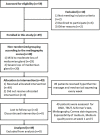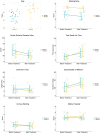Comparative study on the effect of hyperthermic massage and mechanical squeezing in the patients with mild and severe meibomian gland dysfunction: An interventional case series
- PMID: 33684150
- PMCID: PMC7939575
- DOI: 10.1371/journal.pone.0247365
Comparative study on the effect of hyperthermic massage and mechanical squeezing in the patients with mild and severe meibomian gland dysfunction: An interventional case series
Abstract
Background: Meibomian glands exist beneath the palpebral conjunctiva; thus, it is invisible to the naked eye without infrared imaging. This study used meibography to group patients with meibomian gland dysfunction (MGD) and assessed the effects of hyperthermic massage and mechanical squeezing in both groups.
Materials and methods: Patients with MGD were divided into two groups, according to the degree of meibomian gland loss: group 1, in which the sum of eyelid scores ranged from 0 to 4 (mild to moderate gland loss) and group 2, in which the sum of eyelid scores ranged from 5 to 6 (severe gland loss). Hyperthermic massage and mechanical squeezing were given to both groups once a week for 4 weeks, and only non-preservative artificial tears were allowed. Ocular surface disease index (OSDI), Schirmer's test, meibography score, tear break-up time (TBUT), ocular surface staining, expressible meibomian gland, and quality before and after treatment were compared.
Results: Of the 49 patients who completed the 4 weeks of treatment and the evaluation at week 5, 29 were assigned to group 1 and 20 were assigned to group 2. Meibography scores, OSDI, TBUT, and expressibility of meibum had significant differences before and after treatments in both groups. However, there was no significant difference between the changes in clinical signs between group 1 and 2 after treatment. Without grouping, all patients showed significant decreases in meibography score, OSDI, cornea staining score, and increases in TBUT and expressibility of meibum after treatment.
Conclusions: Considering the results of the current study, hyperthermic massage and mechanical squeezing may be effective in patients with meibomian gland loss, regardless of the degree of severity.
Conflict of interest statement
The authors have declared that no competing interests exist.
Figures
Similar articles
-
Mechanical meibomian gland squeezing combined with eyelid scrubs and warm compresses for the treatment of meibomian gland dysfunction.Clin Exp Optom. 2017 Nov;100(6):598-602. doi: 10.1111/cxo.12532. Epub 2017 Mar 12. Clin Exp Optom. 2017. PMID: 28295626
-
Intense pulsed light improves signs and symptoms of dry eye disease due to meibomian gland dysfunction: A randomized controlled study.PLoS One. 2022 Jun 23;17(6):e0270268. doi: 10.1371/journal.pone.0270268. eCollection 2022. PLoS One. 2022. PMID: 35737696 Free PMC article. Clinical Trial.
-
Effect of the Meibomian Gland Squeezer for Treatment of Meibomian Gland Dysfunction.Cornea. 2018 Oct;37(10):1270-1278. doi: 10.1097/ICO.0000000000001682. Cornea. 2018. PMID: 30004957 Clinical Trial.
-
In vivo Meibomian gland imaging techniques: A review of the literature.J Fr Ophtalmol. 2020 Apr;43(4):e123-e131. doi: 10.1016/j.jfo.2019.11.003. Epub 2020 Jan 9. J Fr Ophtalmol. 2020. PMID: 31928786 Review.
-
Intense pulsed light (IPL) therapy for the treatment of meibomian gland dysfunction.Cochrane Database Syst Rev. 2020 Mar 18;3(3):CD013559. doi: 10.1002/14651858.CD013559. Cochrane Database Syst Rev. 2020. PMID: 32182637 Free PMC article.
Cited by
-
Modern Technologies in Demodex Blepharitis Diagnosis and Therapy (Review).Sovrem Tekhnologii Med. 2025;17(3):62-72. doi: 10.17691/stm2025.17.3.06. Epub 2025 Jun 30. Sovrem Tekhnologii Med. 2025. PMID: 40672768 Free PMC article. Review.
-
Immediate and Quantitative Changes in Tear Film Parameters and Meibomian Gland Structures after Warm Compression and Meibomian Gland Squeezing in Meibomian Gland Dysfunction Patients and Normal Subjects.J Clin Med. 2022 Aug 5;11(15):4577. doi: 10.3390/jcm11154577. J Clin Med. 2022. PMID: 35956192 Free PMC article.
References
-
- Schaumberg DA, Nichols JJ, Papas EB, Tong L, Uchino M, et al.. (2011) The international workshop on meibomian gland dysfunction: report of the subcommittee on the epidemiology of, and associated risk factors for, MGD. Invest Ophthalmol Vis Sci 52: 1994–2005. 10.1167/iovs.10-6997e - DOI - PMC - PubMed
Publication types
MeSH terms
LinkOut - more resources
Full Text Sources
Other Literature Sources




